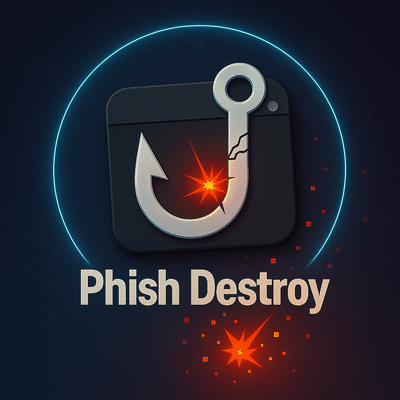About
PhishDestroy is a proactive cybersecurity project with a bold purpose: it doesn’t merely block phishing or scam sites—it seeks to dismantle them. Operating globally, it focuses on eliminating malicious online infrastructure such as phishing operations, cryptocurrency drainer tools, and fraudulent services. Its guiding slogan is: “We don’t block. We burn it all down.”
Mission & Ethos
PhishDestroy’s philosophy is to go beyond passive defense. Traditional anti-phishing tools often protect individual users by blocking access. PhishDestroy, in contrast, strives to neutralize threats at their source, permanently. It is an open source, volunteer-powered cybersecurity initiative, non-commercial in nature, and driven by OSINT (open source intelligence).
Key aspects of its ethos include:
- Active destruction of scam infrastructure, not just warning the public.
- Transparency in intelligence gathering and in the methodology.
- Community engagement and open repositories so that others can build upon or integrate with its work.
Operational Model
PhishDestroy employs a four-phase operational cycle that ensures systematic coverage and effectiveness. These phases are:
- SCAN (Always-On) – Autonomous reconnaissance of potentially malicious domains or services.
- HUNT (Active) – Deep infrastructure mapping, correlating assets, threat actor analysis.
- STRIKE (Relentless) – Coordinated takedowns via domain registrars, hosting providers; IP null-routing; enforcing removal of malicious content.
- ERASE (Permanent) – Ensuring that once infrastructure is neutralized, it is not easily reestablished; persistent cleanup.
This model combines automation, human analysis, enforcement, and follow-through.
Tools & Infrastructure
PhishDestroy’s strength lies in its technical framework, comprised of several open source tools and public repositories. Some of the key components:
- destroylist: A dynamic blacklist of phishing and scam domains. It includes “live threat” feeds and a historical archive spanning over five years and more than 500,000 domains. Provided in JSON formats, it is intended for integration with firewalls, DNS resolvers, browser extensions, researchers, and similar security tools.
- ScamIntelLogs: An evidence archive capturing scammer communications (especially Telegram dumps), operational data, and investigations. Aims to preserve transparency and help researchers and law enforcement understand threat actor behavior.
- Anti-Phishing-Research: An offensive tool that allows generation of fake data or payloads to pollute phishing kits’ data submission endpoints—e.g. credentials or cryptographic seed phrases—to degrade their usefulness. Uses technologies like React, Node.js, TypeScript.
- Integration with community tools in the Web3 security space, including forks of existing projects that detect phishing domains targeting cryptocurrency users.
Takedown Lifecycle, Policy & Enforcement
PhishDestroy does not simply catalog malicious domains; it actively works to dismantle them:
- Once a domain is identified (via scanning) and verified (via analysis), a formal complaint is filed with the domain registrar and hosting provider. The complaint includes evidence such as scan reports, screenshots, and a request for corrective action.
- It leverages ICANN regulations to compel registrars to act, often reminding them of their obligations under policy rules. This adds regulatory pressure.
- It also creates public records (e.g. when a domain is added to the public blacklists), which may serve as evidence for liability for providers who do not act timely.
Impact & Metrics
PhishDestroy measures its success in both breadth (how many domains) and depth (how many networks, actor cells, etc.):
- Neutralized over 500,000 malicious domains cumulatively.
- Dismantled more than 25 full infrastructure / criminal networks.
- Mapped over 15 threat actor cells.
- Neutralized over 50 crypto-drainer kits.
These results underscore the project’s capability to move beyond simple blocking lists and actually reduce threat actor capacity.
Future and Outlook
PhishDestroy is developing its next version (“PhishDestroy v3”). Planned improvements include:
- A deep learning-based detection engine, to enable more predictive threat intelligence.
- A public API for real-time threat intelligence sharing, allowing other security tools and services to leverage its data continuously.
These upgrades are intended to scale its reach and effectiveness while maintaining transparency and community involvement.
Significance
PhishDestroy represents a new paradigm in cybersecurity. Instead of relying solely on reactive or preventative defense, it incorporates offensive disruption, OSINT, and transparent community participation. Its tactical combination of technical tools, policy leverage and public pressure makes it a model of decentralized, cooperative cyber defense—a complement to law enforcement and traditional security firms.

